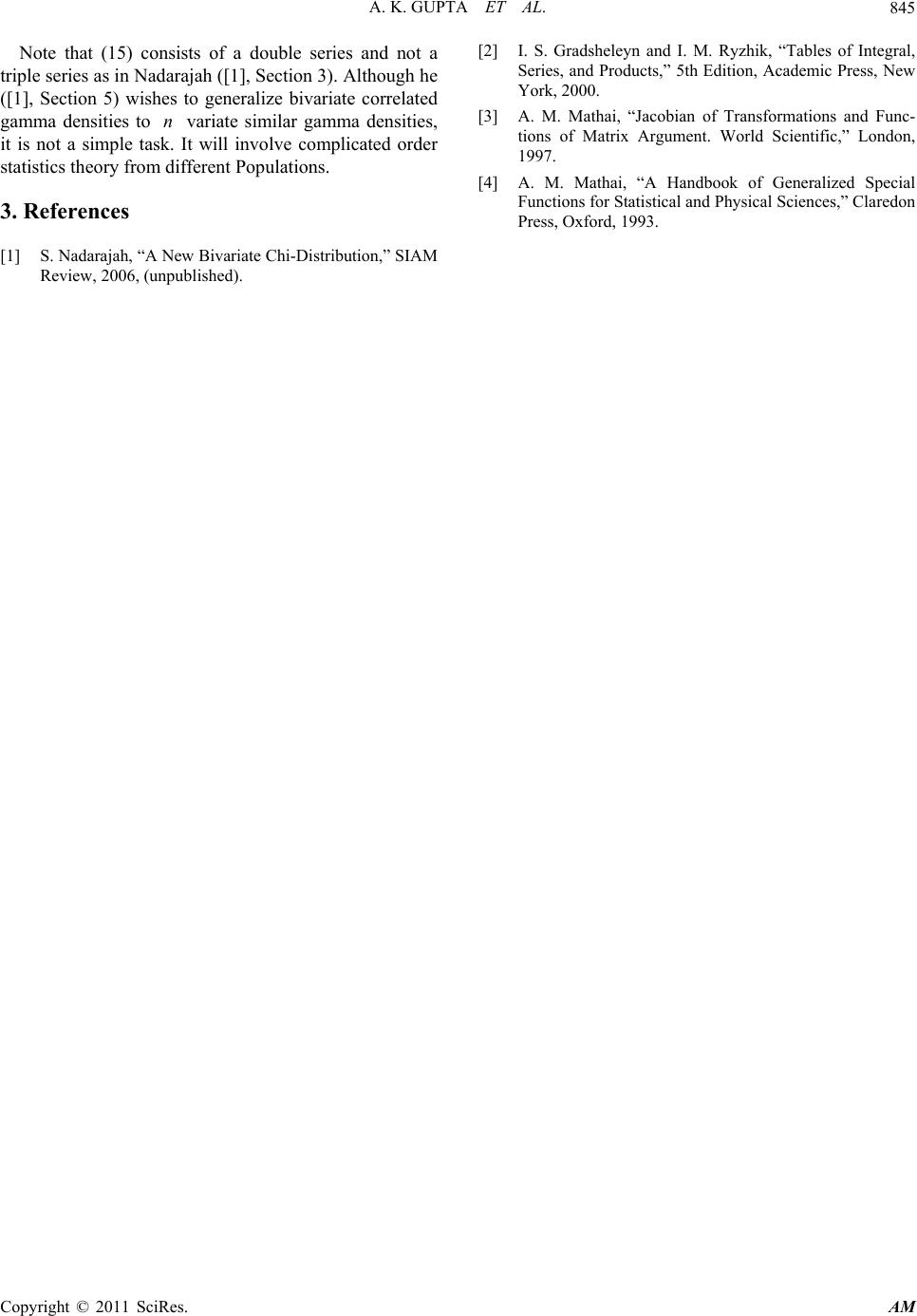Paper Menu >>
Journal Menu >>
 Applied Mathematics, 2011, 2, 843-845 doi:10.4236/am.2011.27113 Published Online July 2011 (http://www.SciRP.org/journal/am) Copyright © 2011 SciRes. AM A New Bivariate Gamma Distribution Arjun K. Gupta1, Dattatraya G. Kabe2 1Bowling Green State University, Bowling Green, USA 25971 Greensboro Drive , Mississauga , Canada E-mail: gupta@bgsu.edu Received March 27, 201 1; revised May 18, 2011; accepted May 21, 2011 Abstract Following Nadarajah [1], we introduce a new bivariate correlated type Gamma distribution, whose joint density is expressed in two parts. Expressions for single and joint moments of the variates are derived. Bivariate Correlated Wishart density follows on similar lines. Keywords: Gamma Distribuion, Correlated Gamma Variates, Moments, Gauss’ Hypergeometric Series 1. Introduction We have joint density of three independent gamma random variables 11 1 ,, =exp ab c huvwKuvwu v w (1) where , as a generic letter, denotes the normalizing constant of a denstiy function in this paper. Setting K =,=uxwuyw the joint denstiy at ,, x yw is 11 1 ,, =exp ab c huvw . K xwywwxy w (2) As in Nadarajah [1], if < x y =wy , then we set , and if , then we set , and integrate out . This is done by using Gr adshteyn and Ryzhik ([ 2], 3.385) result , and we find that (See Equation (3)) =wxt t <yx t where, =0 =0 1 ,,,, =!! =2;; ; j k jk k jk jk x y rxy rjk Frxy (4) However, Nadarajah [1] does not express the density (3) in terms of 21 F . The series is one of the several of Lauricella's series, and Mathai ([3], Theroem 5.59) gives ,,,,rxy an integral representaion of . We use this integral representation to show that can be expressed as 1 2 F . To calculate single or joint moments of x and , we set y 1221 22 =,=;,:,=,if < x yJxy x y (5) 1221 22 =,=;,:,=,if < . y xJxy x y (6) Similarly , if < x y , then we set =yxz , 0< < x z and integrate out to obtain the marginal denstiy of z x . However, if , then we must integrate out from 0 to <yx y x , by using certain known integral results like 1 0=0 0 ! expd =exp! x k p xp pk y p yy yyk (7) to obtain the marginal density of x . However, all such results are already available in advanced calculus books or in the books of collected results on integrals and series. 2. The Moments Mathai [4] shows that the Lauricella’s series can be written as 11 11 exp,1,,,if < ,= exp,1,,,if < . ac b abc x K xyxy cbacyxy y hxy y K xyxyc abcxyx x (3)  A. K. GUPTA ET AL. Copyright © 2011 SciRes. AM 844 1 11 11 111 1 0 111 1 1 =0 =0112 ,, ,;;, ,=111dd ()()() =. !!! n b ca b an Dnn n r r nnn n n rr nn Fabbc xxKuuuxuxuu arrb rbr n x x crrrr r (8) He ([3,4]) also records several integral representation of the series D F . The context one is Mathai ([3], Theorem 5.59, p. 3 45 ) 1 11 1 11 111 1 ,,;;, , =exptr ;;d d Dn n bgbg n nn nn n Fab bcXX KTTTT FacXTXT TT (9) where 11 ,,,,, nn X XT T apos pos definite sym- m re ppitive definite symmetric matrices and 2= 1gp. If A and B are two itive pp nonceetric matrices having ntral Wishart densities with respective noncentrality parameter matrices and and degree of freedom n and q, then w knowat e th 1 11 0 00 =exptr;; dd=exptr;, ng qgnqg F ABD A BA BFnFqABKDDnqD (10) We write some what incorrectly , but formally the re sult (10) as 0110 1 0 ;;=; . F nAFqBFnqAB (11) Now from (9) 0 0 0 0 11111 111 11 11011 112 121 11 11011 ;;F acX=exp tr;ddd =exp tr;;ddd =exp tr(;()())ddd =exp tr;;ddd ag nnnn n ag nnn n ag nnn ag nnn n TXTZZFcXTXTZTT ZZFcXTZFcXTZZTT Z ZFcXXXTT TZZTT ZZFcXTZFcXTZZTT 11121 2 =;;nn FacXXXT TT (12) where and hence from (9) and (12) we have 1 =n cc c 112211 12 ;, ,;;,, ,=;;;. Dn nnn F abbcXXXFabbcXXX (13) The marginal density of , setting z x y = x , if < x y , is 11 111 =0 1 1 =0 =exp2d =exp ! =exp2;; ! ab ar br c r r hxKxwxw zx z wzw br d 2dd K xwz wxzwzw r br br KxFcac rrx (14) Similarly, usi ng (7) we can find the m argi nal density of x , when < x y. Then using (5),(6) and (14) we find that 21 1 3 21 1 3 1 <<=1,;1;,1;; 2 1 1,;1;, 1;;;1 2 mn mn ExyxyExyy xFbnmncFcbmncbac ;1 F anmncFc amncabc (15) The integral in (15) is evaluated by using first (5), (6), and then 11 11 2 011 d=1;1;; 1 nmnp mnp m xx xxKFnmn . (16)  A. K. GUPTA ET AL.845 Note that (15) consists of a double series and not a triple series as in Nadarajah ([1], Section 3). Although he 1], Section 5) wishes to generalize bivariate correlated a [1] S. Nadarajah, “A New Bivariate Chi-Distribution,” SIAM (unpublished). [2] I. S. Gradsheleyn and I. M. Ry Series, and Products,” 5th Editi York, 2000. ([ gmma densities to n variate similar gamma densities, it is not a simple task. It will involve complicated order statistics theory from different Populations. 3. References Review, 2006, zhik, “Tables of Integral, on, Academic Press, New [3] A. M. Mathai, “Jacobian of Transformations and Func- tions of Matrix Argument. World Scientific,” London, 1997. [4] A. M. Mathai, “A Handbook of Generalized Special Functions for Statistical and Physical Sciences,” Claredon Press, Oxford, 1993. Copyright © 2011 SciRes. AM |

